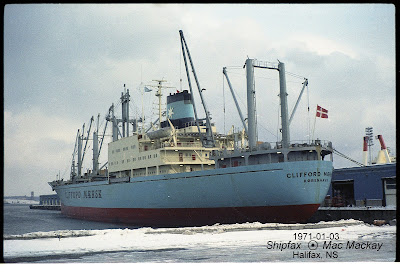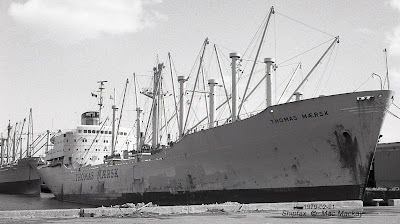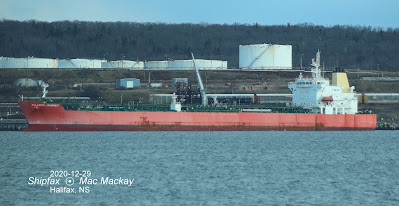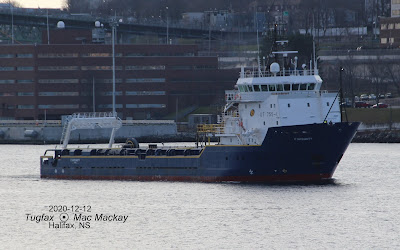I guess most of us will be pleased to see the end of 2020. However there must certainly be widespread consternation about 2021 as to whether it will be more of the same, a return to normal or the advent of a "new" normal. A transition of some sort is inevitable.
There was also anxiety, but on a different scale, in the shipping world, fifty years ago as containers were making a significant impact on how cargo was transported. Hard as it is to believe today, Maersk Lines, now the world's largest container operator, was slow to make a commitment to containers. Much of its trade was with Asia where things were still done in the traditional way. Therefore Maersk was still building conventional cargo ships.
The handsome
Clifford Maersk was built in 1969 by Bergens MV in Norway. A 10,918 gt, 14,159 dwt ship it was equipped with an array of two 25 tonne cranes, one 60 ton, one 30 ton, ten 10 ton and six 5 ton derricks! It had six holds, some of which were refrigerated and accessed through side doors. It also had tank space to carry latex, vegetable oil or molasses and high flash point liquids. Its massive 9 cylinder B+W main engine propelled the ship at 22.5 knots.
In this early 1971 photo at pier 36, you can see Canron erecting a container crane at Halterm in the background, and so the writing was definitely on the wall as ACL and DART had already started serving Halifax with containers and RoRo.
By 1980 Maersk built a new, longer, cellular forebody for the ship and converted it to a 21,349 gt, 21,349 dwt container ship. They sold it in 1988, and renamed Jian He it lasted until 1988 when it was broken up in Tianjin.
Clara Maersk was built to the similar specs by Kockums MV, Malmo, Sweden in 1968, measuring 11,000 gt, and 14,164 dwt, with one 80 ton, one 25 ton, eight 10 ton and twelve 5 ton derricks. In 1980 it received a similar conversion with a wider, longer forebody, emerging as a 21,609 gt, 25,078 dwt container ship. It served as TFL Adams from 1984-1986, reverting to Clara Maersk until 1988 when it was sold and renamed Yi He. It was not broken up until May 2004.
Another sister of the C class was Chastine Maersk, also built by Bergens MV, but in 1968. The 10,918 gt, 14,169 dwt ship was equally equipped with a veritable catalog of cargo gear.It therefore made for an awkward container carrier.
Later in 1980 it received a similar conversion with a new 11.6 m longer forebody, resulting in a 21,609 gt, 25,007 dwt ship. Sold and renamed
Hui He in 1987 it was reportedly broken up in China in 2002.
Maersk was regularly serving Halifax in 1970 with several similar ships, including Trein Maersk.
Seen here at pier 37, with the Canadian coaster O.K.Service XI at pier 34, they were all handling cargo the old way with slings and palettes, although modern "towmotor" forklifts had taken the place of hand carts.
Built at Maersk's company owned Odense Staalskibs AS, in Denmark, but completed by Burmeister + Wain's Copenhagen shipyard, in 1962 Trein Maersk measured 12,310 gt and 14,387 dwt. Also powered by B+W its speed was listed as 21.75 knots. It was fitted out with one 80 ton, one 25 ton, eight 10 ton and twelve 5 ton derricks.
By 1981 Maersk became fully committed to containers and they sold the ship. It became New Stallion but only lasted until 1985 when it was broken up in China.
Sister ship
Thomas Maersk also dating from 1962 and 12,310gt, 14,390 dwt was built entirely by B+W in Copenhagen. Sold in 1980 and renamed
Sarika B it was scrapped in Kaohsiung in 1982.
Slightly older ships such as Lica Maersk were also smaller, with five holds.
Built in 1962 by AG Weser in Bremen, it was a 6365 gt, 9725 dwt ship also fitted with tanks for vegetable oil, latex or molasses and had a similar outfit of one 80 ton, two 15 ton and twenty 5 ton derricks. It also had side doors (just forward of the "E" in "LINE" and midway aft). Its 10,000 bhp B+W, fitted amidships, gave it a tamer 17.5 knots cruising speed. Ships of this class did not make the cut when it came to the container age, and were sent directly to Kaohsiung, where this one was scrapped in 1980.
Maersk eventually made a successful transition to the "new normal" (although it is being challenged for the number one spot by MSC as noted in yesterday's post) and its trademark blue hulls and seven pointed star continue to be seen in Halifax and in ports around the world.
Shipfax wishes all its readers a successful transition into 2021 and a safe and prosperous new year.
.





















































